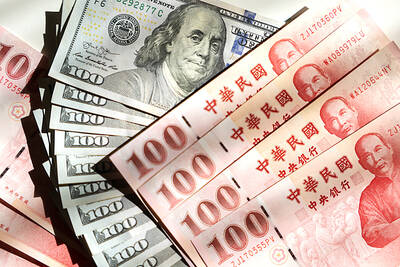The Directorate-General of Budget, Accounting and Statistics (DBGAS) yesterday cut its forecast for Taiwan’s GDP growth this year to 1.42 percent from 1.61 percent amid disappointing exports and private investment data, but said that the economy would gain momentum from this quarter.
If the revised projection bears out, it would be Taiwan’s worst economic performance since 2008, DGBAS Minister Chu Tzer-ming (朱澤民) said, adding that tepid end-market demand and lingering inventory adjustments had forced the cut.
Exports are expected to decline 9.90 percent this year, while imports would tumble 16.87 percent, both worse than the projections in August, Chu said.

.Photo: CNA
Taiwan is home to the world’s main contract suppliers of electronics used in smartphones, personal computers, vehicles and artificial intelligence applications.
Although major central banks have halted monetary tightening, high interest rates continue to curtail corporate investment and consumer spending, Chu said.
That is why the IMF last month trimmed its growth forecast for global trade by 1.1 percentage points to 0.9 percent, which is unfavorable for Taiwan’s export-reliant economy, he said.
However, the clouds have started to dissipate, he said.
The the economy is set to expand 5.22 percent this quarter as technology brands launch new-generation gadgets and restock inventory ahead of the holiday season, he said.
Exports would rise 2.89 percent in the October-to-December period, but imports would contract 7.45 percent due to languid interest in purchases of input materials and capital equipment on the part of local firms, the DGBAS said.
Private investment would slump 11.91 percent this quarter, easing from a 13 percent fall last quarter, as firms stood by a cautious business approach to cope with geopolitical tensions and restrictive interest rates, Chu said.
The GDP component would fall 9.81 percent for the whole of this year, much more than the 5.93 percent retreat the statistics agency predicted three months earlier, the DGBAS said.
Private consumption helped buoy the nation’s economy this year with an 8.36 percent increase as people emerged from COVID-19 restrictions, it said.
Exports and private investment would once again be growth drivers next year, helping lift GDP to 3.35 percent, a mild gain from the estimate in August, Chu said.
“We are looking at stable growth in exports, private investment and consumer spending,” he said, adding that low bases also help.
Major tech firms would raise capital expenditure to maintain their leadership positions in advanced technology processes, while domestic airline companies are expanding their fleets to meet demand for cargo and passenger services.
The government has announced a 4 percent rise in the minimum wage next year, which would help private consumption remain healthy, Chu said.
Consumer prices would return to near the central bank’s target of 1.64 percent, although they are set to rise 2.46 percent this year as bad weather drove up fruit and vegetable prices, he said.

MARKET LEADERSHIP: Investors are flocking to Nvidia, drawn by the company’s long-term fundamntals, dominant position in the AI sector, and pricing and margin power Two years after Nvidia Corp made history by becoming the first chipmaker to achieve a US$1 trillion market capitalization, an even more remarkable milestone is within its grasp: becoming the first company to reach US$4 trillion. After the emergence of China’s DeepSeek (深度求索) sent the stock plunging earlier this year and stoked concerns that outlays on artificial intelligence (AI) infrastructure were set to slow, Nvidia shares have rallied back to a record. The company’s biggest customers remain full steam ahead on spending, much of which is flowing to its computing systems. Microsoft Corp, Meta Platforms Inc, Amazon.com Inc and Alphabet Inc are

Luxury fashion powerhouse Prada SpA has acknowledged the ancient Indian roots of its new sandal design after the debut of the open-toe footwear sparked a furor among Indian artisans and politicians thousands of miles from the catwalk in Italy. Images from Prada’s fashion show in Milan last weekend showed models wearing leather sandals with a braided design that resembled handmade Kolhapuri slippers with designs dating back to the 12th century. A wave of criticism in the media and from lawmakers followed over the Italian brand’s lack of public acknowledgement of the Indian sandal design, which is named after a city in the

INVESTOR RESILIENCE? An analyst said that despite near-term pressures, foreign investors tend to view NT dollar strength as a positive signal for valuation multiples Morgan Stanley has flagged a potential 10 percent revenue decline for Taiwan’s tech hardware sector this year, as a sharp appreciation of the New Taiwan dollar begins to dent the earnings power of major exporters. In what appears to be the first such warning from a major foreign brokerage, the US investment bank said the currency’s strength — fueled by foreign capital inflows and expectations of US interest rate cuts — is compressing profit margins for manufacturers with heavy exposure to US dollar-denominated revenues. The local currency has surged about 10 percent against the greenback over the past quarter and yesterday breached

The US overtaking China as Taiwan’s top export destination could boost industrial development and wage growth, given the US is a high-income economy, an economist said yesterday. However, Taiwan still needs to diversify its export markets due to the unpredictability of US President Donald Trump’s administration, said Chiou Jiunn-rong (邱俊榮), an economics professor at National Central University. Taiwan’s exports soared to a record US$51.74 billion last month, driven by strong demand for artificial intelligence (AI) products and continued orders, with information and communication technology (ICT) and audio/video products leading all sectors. The US reclaimed its position as Taiwan’s top export market, accounting for